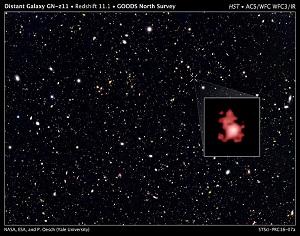Image: Hubble Space Telescope image shows the Galaxy GN-z11, shown in the inset, as it was 13.4 billion years in the past, just 400 million years after the big bang, when the universe was only three percent of its current age, in this image released by NASA on March 3, 2016. The galaxy is ablaze with bright, young, blue stars, but looks red in this image because its light has been stretched to longer spectral wavelengths by the expansion of the universe.
REUTERS/NASA, ESA, P. Oesch (Yale University), G. Brammer (STScI), P. van Dokkum (Yale University), and G. Illingworth (University of California, Santa Cruz)/Handout via Reuters
![]()
By Irene Klotz
CAPE CANAVERAL, Fla. (Reuters) – Astronomers said on Thursday they had discovered a galaxy that formed just 400 million years after the Big Bang explosion, the most distant galaxy found to date.
Located a record 13.4 billion light-years from Earth in the direction of the constellation Ursa Major, the galaxy, named GN-z11, was first spotted two years ago in a Hubble Space Telescope deep-sky visible light survey.
At the time, astronomers knew they were seeing something very far away, possibly as distant as 13.2 billion light-years from Earth.
Follow-up observations with an instrument on Hubble that splits light into its component wavelengths revealed that GN-z11 was farther away than initially believed, setting back the galaxy-formation clock by another 200 million years.
Being able to use Hubble to peg the galaxy’s distance was a surprise, said astronomers who will publish their research in next week’s issue of The Astrophysical Journal.
“We’ve taken a major step back in time, beyond what we’d ever expected to be able to do with Hubble,” Yale University astronomer Pascal Oesch said in a statement.
The key to the discovery was precisely measuring the shift of the galaxy’s light into longer, redder wavelengths, which directly corresponds to how far the photons had traveled before reaching Hubble’s eye.
The phenomenon is similar to the sound of a train whistle shifting pitch as it recedes into the distance.
Though small by modern galaxy standards, GN-z11 is huge considering it formed at a time when the universe was only 3 percent of its present age, said astronomer Garth Illingworth with the University of California, Santa Cruz.
“We’re seeing this galaxy in its infancy,” Illingworth said. “It’s amazing that a galaxy so massive existed only 200 million to 300 million years after the very first stars started to form.”
GN-z11 contains about 1 billion times the mass of the sun. The galaxy is about 25 times smaller than the Milky Way, though it is pumping out new stars 20 times faster than the present Milky Way.
Astronomers said they expected the new distance record to stand until Hubble’s successor, the James Webb Space Telescope, is launched in 2018.
(Reporting by Irene Klotz; Editing by Ian Simpson and Sandra Maler)
Copyright 2015 Thomson Reuters. Click for Restrictions.
Hubble-telescope-s-latest-find-pushes-back-clock-on-galaxy-formation-media.jpg


